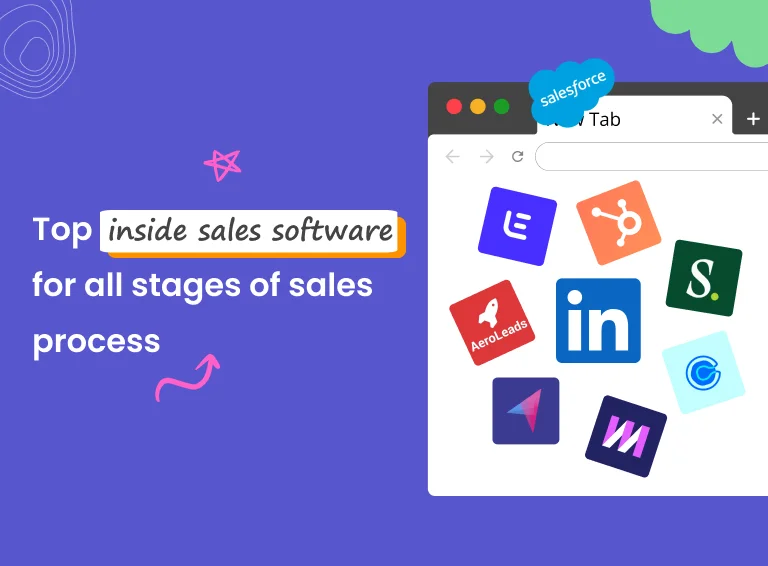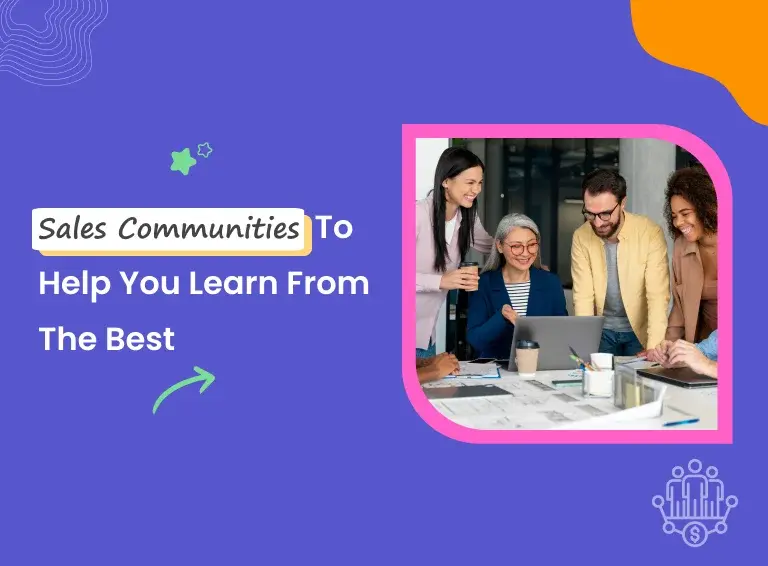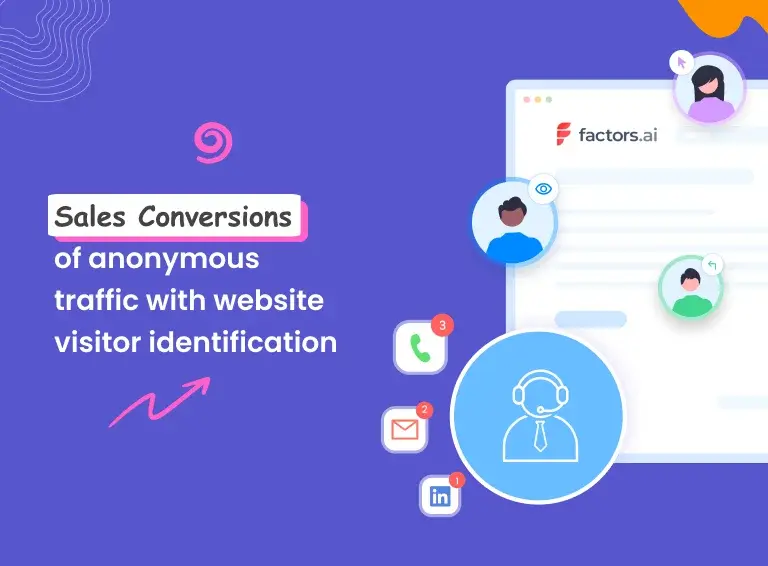If you lead a team or are part of a team that does any outbound prospecting, Predictable Revenue, by Aaron Ross and Marylou Tyler, is a must-read book for you.
In recent times, one of the most influential books on the topic, Predictable Revenue provides a step by step process to achieve repeatable and scalable lead generation through outbound - without the traditional cold calling.
But, at 200 odd pages, it is not something you can consume over a coffee.
We definitely recommend taking the time over a weekend to get into the book and explore all the concepts in finer detail.
In this summary, we have crystallized the key takeaways from the book. And presented in an easy to consume format that you can absorb with your morning latte.
Read on to get a gist of the book in 15 minutes.
Think of this as the miniature that gives you a taste of what the chocolate is like. But we recommend you to devour the whole book at your leisure.
Predictable Revenue - A Quick Summary
The book, Predictable Revenue is categorized into 11 chapters:
- Chapter 1: Where the $100 million came from. Gives a brief outline of the book.
- Chapters 2-3: Cold Calling 2.0 techniques. The essence of the book - outbound prospecting strategy Cold Calling 2.0 is covered in these chapters.
- Chapters 4-6: Best practices to build a repeatable sales process. These chapters get into the nitty-gritty of building a repeatable and scalable sales process.
- Chapters 7-11: Aligning leadership with talent. These chapters explore the hiring and management practices of sales professionals.
Repeatable Lead Generation: The First Step To Effective Sales
The book proposes that the fundamental step to building predictable revenue - to achieve consistent, year-after-year growth - is to steadily generate high-quality leads.
Only when there’s a consistent flow of qualified leads into your pipeline - will you have a constant flow of new customers that’ll help create predictable revenue.
A 'Lead' is a prospect that has responded positively or shown some interest in your offering, such as signing up for a free-trial or filling up a form on the website, etc.
The book categorizes leads into three types: Seeds, Nets, and Spears.
- Seeds: Seeds are the leads you find through channels like organic internet search/SEO, local user groups, social media or publishing expert content. Although it takes some time to cultivate and nurture these leads, they’re unbeatable with the highest conversion and close rates.
- Nets: Nets are the leads generated through classic marketing programs targeted at a large audience.
- Spears: Spears are the leads generated through targeted outbound efforts such as business development, Cold Calling 2.0, etc. Generating these leads requires some individual human efforts.
Specialized Sales Roles to Focus On Prospecting
Salespeople typically handle three activities: prospecting, qualifying, and closing. These are three distinct responsibilities and require different skill sets to be successful.
It is unreasonable to expect your salespeople to switch between different mindsets throughout the day and still consistently generate new business.
For these very reasons, the authors recommend splitting your sales team into three different categories:
- Sales Development team: This team is solely focused on prospecting. The only mission of this team is to create new, qualified opportunities from cold (ones you didn’t know at which you didn’t have a previous relationship) or inactive accounts and passing them to a quota-carrying salesperson to close.
- Market Response Team: This team is focused on qualifying inbound leads. The only motive of this team is to qualify marketing leads coming through website or word-of-mouth programs and assign qualified opportunities to the appropriate quota-carrying salesperson.
- Account Executives: Account Executives are the quota-carrying salespeople that focus on closing the qualified opportunities passed over to them. Account Executives don’t spend their time on prospecting activities. Rather they focus on higher-potential sources of business such as a small targeted list of strategic accounts, developing referrals, current customer base, etc.
Creating dedicated sales teams for different activities will ensure your salespeople work on what they do best. This will dramatically improve their productivity and make a significant impact on revenue generation.
On the whole, the idea is to:
- Focus your Account Executives on low volume but high-value activities, such as building relationships at key accounts.
- Specialize your sales reps to take over low-value yet high-volume activities such as prospecting into cold accounts.
Cold Calling 2.0
Cold Calling 2.0 is an outbound sales methodology that involves prospecting into cold accounts to generate new business - without using any cold calls.
The purpose of this framework is to have a process in place that’ll help generate new pipeline and leads predictably - that is, if an organization puts in “x efforts”, they should know it will lead to “y results”.
Unlike the traditional cold calling technique, Cold Calling 2.0 is different in the following ways:
a. No Cold Calling
Instead of using cold calling to get in touch with prospects, the framework recommends sending cold emails to generate referrals to the decision-makers first, who then are likely to expect your call.
b. A Focus on Results, Not Activities
Once you generate referrals through cold emails, you can set up a “qualification call” with these prospects trying to learn if there’s a mutual fit.
Tracking these metrics such as qualification calls made per day, qualified opportunities generated per month, etc - unlike metrics like calls/dials made per day in Cold Calling 1.0 - will help you set more realistic goals about your pipeline.
c. Everything Is Process-Driven
Cold Calling 2.0 lays great emphasis on repeatability and consistency in management practices, hiring, training, etc.
This leads to a predictable pipeline and the entire team’s results become sustainable.
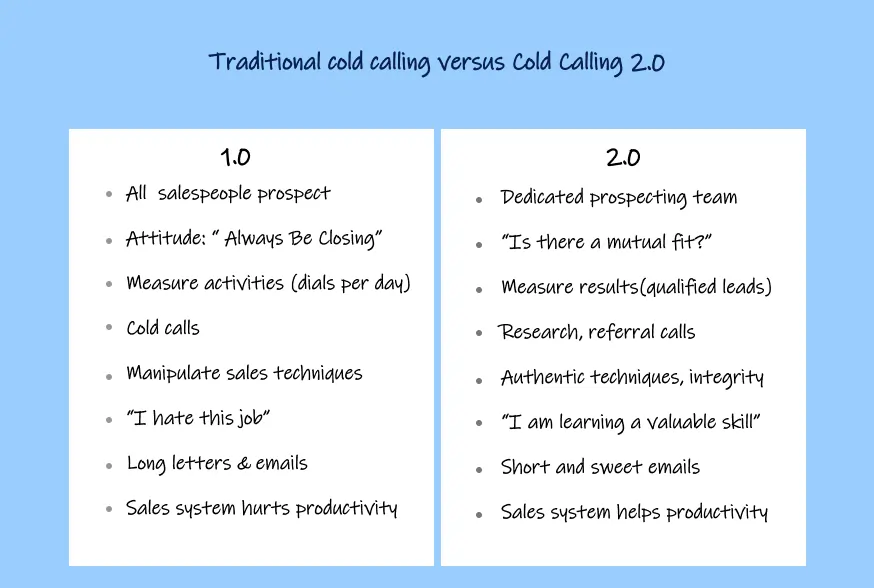
Executing Cold Calling 2.0
The formula is simple. Outbound sales prospecting helps generate predictable leads. And predictable lead generation leads to predictable revenue.
Once you have a dedicated role/team for outbound prospecting - whose only job is to generate qualified opportunities for your quota-carrying Account Executives, here’s the five-step framework you should follow:
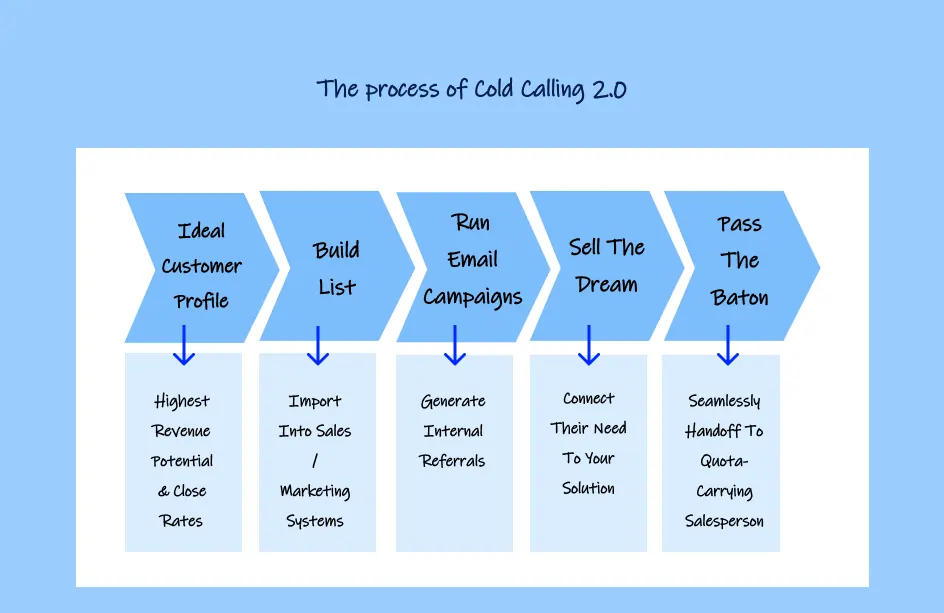
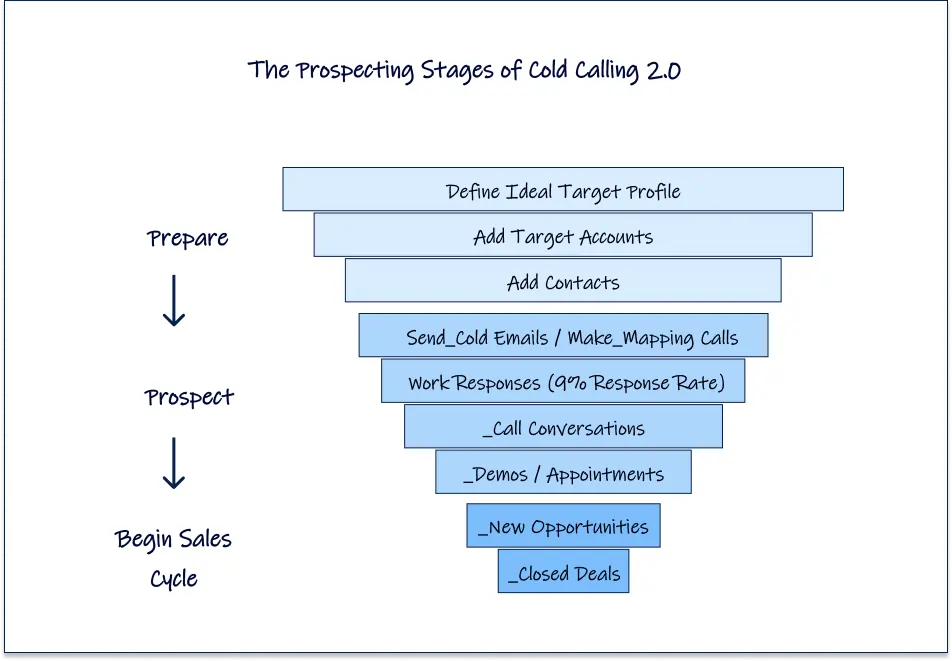
Step 1: Build Your Ideal Customer Profile
Understand who your Ideal Customer is - who they are, what are their core challenges, red flags/deal-breakers if any and even ideal contacts to get in touch with.
Having a clear-cut definition of your Ideal Customer Profile (ICP) helps you quickly:
- Find great prospects through smart targeting.
- Disqualify poor prospects.
a. Smart Targeting: Define 3-5 criteria of your Ideal Customer.
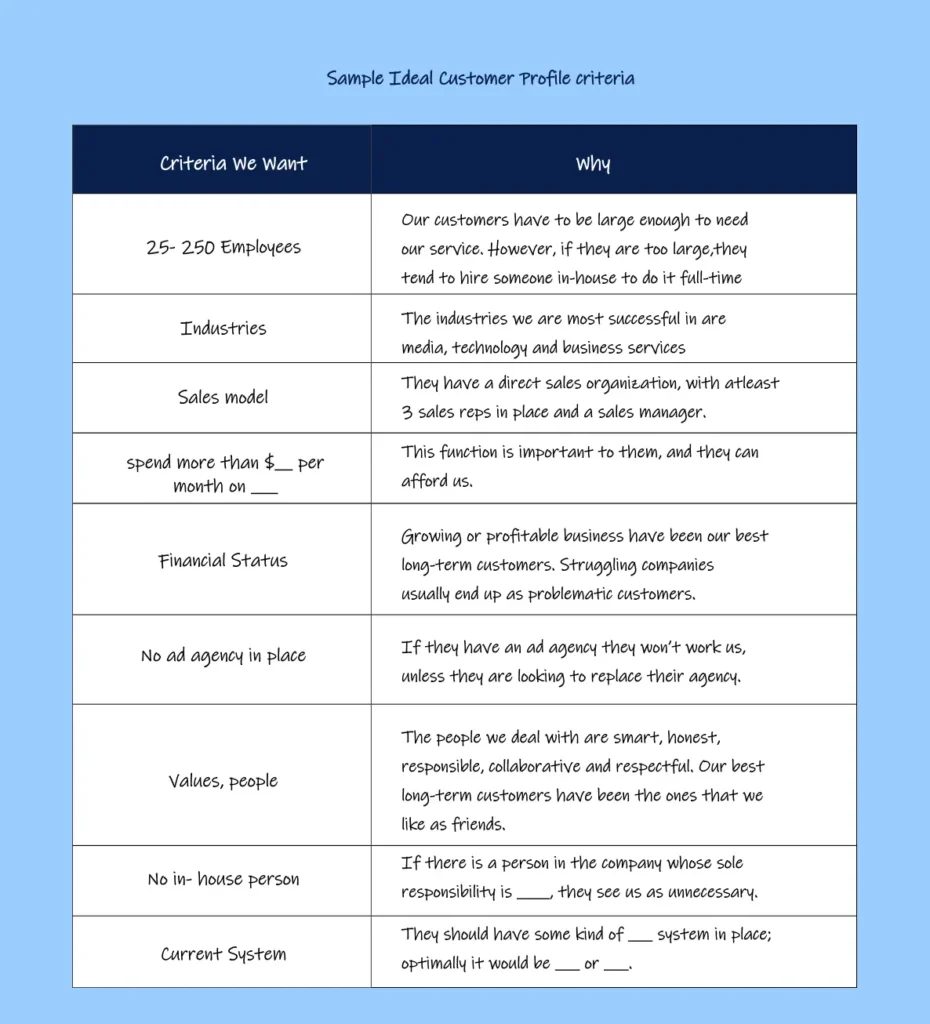
b. Decode their core challenges: Figure out the core challenges of the companies and individuals in the buying process. Ask them questions like:
- What are your biggest challenges?
- What are your main frustrations?
- What’s most important to you?
- Where do you spend your money?
c. Red Flags/Deal Breakers: Keep an eye out for signals that warn you against working together or indicate a potential bad fit such as budget constraints, history, recent investments, geography, etc.
Step 2: Build Your List
The next step of this framework focuses on building your own list of targeted prospects. Do you have decision-makers or lower-level people?
Are you targeting companies/people based on your ICP? Or are you randomly cluttering your list with irrelevant prospects?
Randomly throwing in prospects that don’t fit your customer criteria will only clutter your database and waste your time eventually - it’s better to keep away from such practices.
Also, try using prospecting tools to make your job more effective and maybe - a little easier. Experiment with tools to identify what works best for you.
Different prospecting tools suit different businesses, pick one that suits your business best.
Step 3: Run Outbound Email Campaigns
Running cold email campaigns is the step that gets you in front of new prospects.
The framework insists on starting with cold emails for outreach and then using calls to follow-up with people that respond.
a. Start Small:
Start by sending 50-100 prospecting emails every few days a week as an outreach campaign. Send no more than 150-250 outbound emails per week, over a course of 3-4 days.
Your goal should be to generate around 5-10 responses per day - roughly about a 10% response rate. More than that gets difficult to manage.
b. Market Segmentation:
To make your emails look targeted, divide your target prospects based on some common characteristics such as business model (B2B, B2C, agency), revenue, contact title, demographics, how they learned about you, etc.
Market Segmentation will help your emails look like they’re a single email craft specifically for a prospect from a salesperson.
Moreover, it helps you reach out with the most suitable messaging for individual prospects - so that it best resonates with them - and compel them to take action.
c. Writing Your Emails:
The idea of these emails is to start a conversation. Here are a few basic guidelines:
- Keep your mails short. Be honest and to the point - why are you reaching out?
- The mail should be text-based - no fancy HTML.
- Optimize your emails for the smartphone. Make it easy to read and respond.
- Offer credibility (give examples of customers)
- Ask one simple-to-answer question in the end (such as for a referral).
d. Campaign Guidelines:
- Don’t aim for getting more than 5-10 responses per day - else, they’re likely to slip through the cracks.
- You’re bound to get a lot of bounces from newly built or purchased lists - make sure to exclude these email addresses from your database regularly.
- It’s vital to log every single response that you get into a sales automation software. This will keep you organized and ensure that no responses fall through the cracks.
- Tracking engagement metrics like opens, clicks, etc provide insights about your most interested prospects and prioritize accordingly.
e. When You Get a Response:
- The goal of every email that you send should be to move the prospect one step further to the close.
- To move things further, you can ask either of these two questions in your mail: Who is the best point of contact for …? (to get a referral) or when is the best day/time for a quick discussion around ..?” (to set up a conversation with the prospect)
- For getting a referral, the idea is to confirm the best point of contact for a first conversation and get referred to them. You can then email the new contact while mentioning the person that referred you.
- For the second goal, the objective is to set up a quick call to see if there’s a mutual fit between your company and your prospect’s company. These calls are called scoping or prospecting calls. The purpose of these calls is to get your prospect talking. Ask them some open-ended questions and encourage them to talk about their business.
- If someone tells you that they’re not interested, figure out why. Find out if the “no” is coming from an objection that you can handle. Make sure you clearly convey your value proposition.
- Also, understand that a “no” doesn’t matter unless it is coming from a key decision-maker.
- Old Opportunities Campaign: Train your new salespeople to generate new opportunities by reaching back to old opportunities that have died or become inactive for more than 6 months.
Step 4: Sell the Dream
In this part, the book suggests helping your prospects paint a picture of:
- The solutions they need to solve their problems.
- Connect your product to their key business issues and explain how it can help them.
The book emphasizes that sales reps should take time to determine if there’s actually a fit by seeing if they’re connected to the right people (decision-makers) if their prospects are serious about taking action and are willing to take the next step.
Once a sales rep determines that a prospect is a good fit, the next task is to stay focused on the prospect’s business - and not yours.
Here are a few questions that’ll help you gather information straight from the horse’s mouth. Ask any 3-4 questions:
- How are your “x” teams/functions organized?
- What systems do these teams use for marketing and lead generation?
- How long has the system been in place?
- Why did you buy the old system? Who decided to purchase it?
- What are your challenges now? (Keep asking “what else” after each answer)
- Have you been looking at alternatives yet?
- Have you tried and failed with other solutions? Why?
Few more important tips:
- Always call a person below the C-Suite first to understand how their business works and what their current challenges are.
- Ask straight about their pain-points, in case if it isn’t obvious after your conversation.
- Keep digging deep until you get a complete picture of their challenges and pain-points.
- Always work to schedule your next step while you’re still on the phone.
Step 5: Pass the Baton
The final stage of Cold Calling 2.0 is all about passing a qualified opportunity to the Account Executive and having him to re-qualify the opportunity.
Guidelines for an SDR to Handoff the Opportunity to an Account Executive (AE):
An SDR should consider passing on the opportunity only when:
- The prospective company fits their Ideal Client Profile (ICP)
- If he’s gotten in touch with the decision-maker.
- If the prospect shows a clear interest in going forward. For example, taking a discovery call with an Account Executive.
Once an opportunity fits this bill, the SDR can pass it over to the Account Executive.
The Account Executive then gets on to a call with the prospect and requalifies him against the same criteria - to check if the opportunity was rightly qualified by the SDR.
The SDR is compensated when the Account Executive approves the opportunities passed on to him.
Audit Process for Quality Checking Purposes
Aaron highlights the need for having the manager to do a quality check on the opportunities generated once in a while.
Here are a few guidelines for the audit process:
- Was the opportunity truly an incremental, outbound opportunity?
- Was the opportunity truly re-qualified by the Account Executive?
- Did the SDR and the Account Executive consistently log all the data into the sales automation software? Or did they miss out on any data?
Sales Best Practices To Help Reps Strengthen Their Approach
The authors suggest a “3-Hour-and-15-Minute” sales process to help sales reps quickly qualify an opportunity in the initial stages of a sales cycle.
This structure helps qualify or disqualify an opportunity early, gain access to multiple decision-makers and help create a vision for the prospect.
Here’s the three-step framework:
Step 1: First Contact - 15 Minutes
The book emphasizes on not taking more than 15 minutes of your prospects time to figure out if you make it for a good fit.
Set expectations, layout a process so that both of you can figure out if there’s a mutual fit and position it in a way that benefits them.
For example,
- An in-depth discovery call with all the people likely to be involved in the sale.
- A follow-up call with all the key people team on the team to flesh out how and when to work together.
Step 2: Qualification/Discovery Call - One Hour
If you think there’s a fit, create a plan with the prospect to organize a working session that brings in their key decision-makers to meet and create a vision with your key decision-makers.
The more confident you are about this layout process and why works it for them, the more likely your prospect is to follow along.
Step 3: Group Working Session - Two Hours
Time to implement the plan here. Once you bring in both the parties together, create a joint vision as to how your prospect will be successful with your product.
Coach the vision out of them, rather than just telling them how it works.
How To Build a Good Sales Team?
The authors think that the best way to build a great sales team is to grow and develop your own.
They advise using role-playing to train people on calls, demos, and presentations.
Here’s how you can do that:
- Create a scenario and describe it to the group.
- Select a trainee.
- Other people can pretend to be holding different roles at the prospect company.
- Send off the person to be trained, back to their cube, or another room
- Everyone else goes to the conference room to listen in.
- Trainee dials into the conference room and begins.
The book suggests one self-managing training meeting once every week. It consists of a mix of topics in 10-15 min chunks, such as:
- Product or sales training.
- General business topics such as how to manage people or understanding financial statements.
- Public speaking skills for reps to present to the whole team and get feedback
- Any random fun topic to discuss.
How To Become the Best Sales Manager?
Aaron advocates that an outstanding Sales Manager will be capable of the following responsibilities:
1. Choose people carefully: It’s always better to hire for talent and adaptability than for experience. A fast-learning, hungry hire can make up for a reasonable lack of experience in 6-12 months.
2. Set expectations and vision: The book endorses defining a role in terms of results - not in activities.
He stresses on the importance of laying out a flexible process to help your team achieve results - giving them advice and guidance but allowing them to find their way.
3. Remove Obstacles: The authors suggest creating a frictionless environment for your sales team by setting clear rules of engagement, compensation plans, and sales processes - so that no time and energy are utilized for maximum benefit.
4. Inspire your people: Understand what helps your team to excel and to achieve their full potential.
Good compensation structure, regular compliments on good work, opportunities for career advancement or achieving particular goals helps keep the motivation.
5. Work for your people: Take time to understand your individual salesperson’s life/career goals, then work to help them achieve those goals.
The more you work for your team’s success, the more willing they will be to work for your success.
6. Improve it next time: Aaron suggests periodically going back to these five steps, reflecting on how well they’re working for you and improving them as your company grows.
A Framework To Improve Your Sales Organization
Here are three steps that the book commends to improve your sales organization:
1. Include salespeople while planning new programs: It’s vital to make your sales team feel like they’re a part of the decision-making process.
Make your sales team feel included by voicing their opinions about your sales culture. Ask them regularly for feedback and ideas - how’d they want to manage the sales organization, any changes they’d like to make, etc.
2. Gather feedback about new sales programs: Whenever you’re drafting a new program or rule, make sure to regularly gather feedback from your sales team.
This will help catch any bugs or issues early - before it is released to everyone.
3. Survey satisfaction: Get to know how satisfied your team is with the environment and the support they get. The parts they find frustrating etc.
This tells them that you’re genuinely concerned about their well-being and will raise their morale and engagement - leading to more productive results.
Conclusion
Predictable Revenue fundamentally transformed the structure of outbound sales from a boiler room-style cold calling operation to a targeted hunting process. And broadly, it achieved this in a four-step framework:
- Having two specialized roles in your sales team - one for prospecting and other for closing.
- Systematic execution of the Cold Calling 2.0 technique.
- Consistently experimenting and improving existing techniques to build a repeatable sales process.
- Substantial focus on hiring and development practices.
That’s Predictable Revenue for you in a nutshell!

